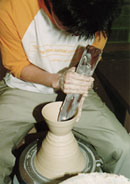There are many steps in the production of Arita ware.
(1) Porcelain stone is quarried (cut out), and then crushed and ground into powder.
(2) The powder is mixed with water to create clay.
(3) The clay is kneaded well, then is formed on a spinning potter's wheel. Spinning the wheel at will
is very difficult and takes a lot of practice. Once the shape is completed, the piece is dried.
(4) In a process known as bisque firing, the piece is fired in a kiln at 900 degrees Celsius, making it
a little sturdier.
(5) Underglaze decoration - patterns, drawings, and paintings - is applied.
(6) A coating called glaze, which becomes glassy when fired, is applied on the entire surface. The underglaze
decoration becomes concealed at this point.
(7) The piece is again fired, this time at a high temperature of about 1,300 degrees. Glaze firing hardens
the piece into mature porcelain, and the surface becomes glassy and transparent, once again revealing
the underglaze decoration.
(8) Overglaze is applied. When using additional colors, like red, yellow, green, and gold, they are applied
after the glaze firing.
(9) Finally, the piece goes through overglaze firing at about 800 degrees. This brings out the brilliant
colors of the overglaze.

WHAT IS ARITA WARE?
Japan produces many types of ceramics that are also popular overseas. One of them is
Arita ware, which has been favored for over 400 years not only in Japan but in Europe as well.
|
|||||||
|
|||||||
|
The Production Process |
|||||||
